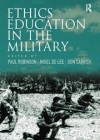Ethics Education in the Military
Written by: Paul Robinson, Nigel de Lee and Don Carrick (eds.),
Ashgate, Aldershot, 2008, 224 pp.
Jointly reviewed by: Lieutenant Colonel (Retd) Alan Howes, Lieutenant Colonel Ian Hampson, Chaplain David Jackson CSM, Dr Stephen Coleman, Chaplain Clyde Appleby RAN, and Flight Lieutenant Alyssa Badgery
There are many who will agree that Ethics Education in the Military is long overdue as required reading for those who deliver ethics training and education programs in democracies worldwide, and for all those interested in the ethics and ethos of the Profession of Arms. This is an invaluable volume for military academies, staff colleges and all ranks training establishments—including recruit training—to enhance understanding of a matter which requires much further thought, and which is becoming a vital force in influencing outcomes on the battlefields of the twenty-first century, including peacekeeping and peacemaking.
Ethics Education in the Military offers updated papers from a conference held at the University of Hull in England in 2006. There are twelve chapters covering ten democratic countries—a thorough and enlightening survey of ethics programs and their underlying philosophies, with analyses and evaluations from Britain, America, Canada, Australia (by Jamie Cullens, Director of the Centre for Leadership Studies at the Australian Defence College, Canberra), France, Germany, Japan, Norway, Israel and the Netherlands. Three perceptive responses (Chapters 14–16) to the preceding Chapters 2–13, question whether military commanders give sufficient thought to the purpose of ethics education, whether the methods chosen for instruction are optimal and evaluated, and how much emphasis should be placed on Servicemen and women thinking for themselves about ethical issues.
Until recently, formal ethics education and training programs were a rarity in most countries’ armed forces. Now there is a growing recognition of the importance of Servicemen and women from all arms of Defence developing their individual character and corporate ethos through undergoing additional military ethics education and training. But how do we ensure all ranks are learning the right lessons? Can we, and should we, endeavour to achieve some uniformity, given the fact of military coalitions? The current lack of uniformity about what constitutes ethical behaviour, and how military members should be educated and trained, is a cause for concern. To recognise what we need demands an understanding of what we have. The reviewers agree with this book’s conclusion (p. 200) ‘that before further progress can be made in the field of ethics education in the military, we may need to some extent to return to basics, and examine in more detail what we consider the moral purpose of armed forces to be, and what therefore the purpose of ethics training should be also’.
Why should this book be reviewed by two serving ADF officers, two chaplains, an academic and a retired soldier, especially when only the academic amongst them has any formal qualifications in philosophy? The reasoning and justification is simple; because military laypeople are at the ‘coalface’ of responsibility for ethics instruction and leadership, we should encourage all ranks to read more widely and so become involved in discussions about ethics in general and military ethics in particular. Ethics Education in the Military advances knowledge and understanding of the issues associated with this subject of ethics teaching and instruction, by bringing together experts from around the world to analyse the content, mode of instruction, theoretical underpinnings, and the effect of cultural and national differences within current ethics programs. It explores whether such programs are best run by military officers, chaplains or academic philosophers, and it asks whether it is feasible to develop common principles and approaches for the military in democracies.
Ethics Education in the Military mentions ethics training to a lesser extent than ethics education and does not attempt to address the implications on pedagogy arising from these distinctions. As Dr Jessica Wolfendale well points out in her response in Chapter 14, those engaged or intending to become engaged in ethics programs in the military must first ask themselves ‘why teach military ethics at all?’, since any answer to this question will have implications on the ‘who, what, when, why and how?’, and whether the resulting program will be primarily an educative process, having developmental goals, or a training process with learning outcomes.
The reader will not find in this book the content for a program of ethics education or training in the military. Neither does the book intend to give answers on the appropriate pedagogy. Nevertheless it does prompt the questions to ask, which in turn give direction on implementing an ethics program. This presents a challenge for those involved in ethics education and training programs in the ADF. We can no longer simply do as we have always done; the nature of military operations is changing, the outlook of the young people entering the ADF today is different and, as Ethics Education in the Military well indicates, the philosophical and ethical views around the world are changing. For these reasons alone, Ethics Education in the Military is essential reading for those involved in ethics education and training in the ADF. The reviewers believe it can be put to good use by military officers and all others involved in ethics education and training in the military such as chaplains and academic lecturers; as well as being of use to politicians and other students of military affairs. This book provides a very valuable survey of a growth subject, and we six reviewers thoroughly recommend it.

